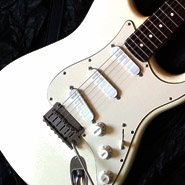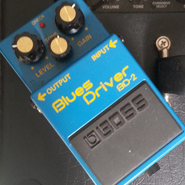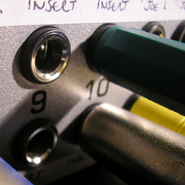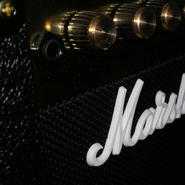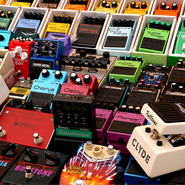This post will outline the relevant aspects of electric guitar for Musical Directors. I’ll cover the common models, give a brief overview of the various controls, touch briefly on amplifiers and demonstrate the main effects used on electric guitar sounds.
I’m aiming this post at Musical Directors in the Musical Theatre world, but it may be useful for any musician, band leader, composer or arranger who wants to understand electric guitar better.
We’ll start with the common models of electric guitar. These can be identified by the shape of the instrument. They’re mostly named after the first model to use that shape. However, they’ve all been copied by other manufacturers, so if your guitarist brings a ‘Fender Stratocaster’ style guitar that’s not made by Fender it’s not necessarily an inferior instrument.
The styles, in no particular order, are:
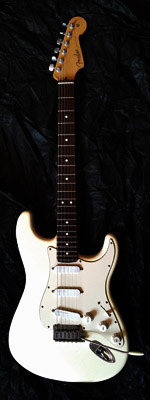
Stratocaster Style
Based on the Fender Stratocaster, or ‘Strat’ for short, this is probably the most common style of guitar you will see in a Musical Theatre pit. Its distinctive features are the three single pickups and double cutaway shape. The shape is so iconic that it’s probably what you imagine when you think of an electric guitar.
(The cutaways are the recesses in the body either side of the neck allowing access to the higher frets)
These guitars are very versatile, which is why they turn up in pits so often. Their sound is quite bright, which helps them be heard even when there are many other instruments. They are common in almost every style of music, which helps in Musical Theatre where the tone required can vary significantly from one number to the next.
The only style they’re less popular for is Jazz, where their brightness is considered undesirable. A competent guitarist can dial in a passable Jazz sound if needed for a few numbers. However, if the whole show needed a Jazz tone then I’d normally bring a different guitar.
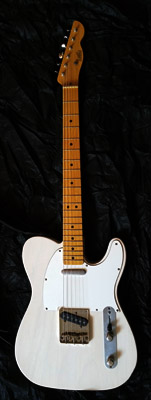
Telecaster Style
Based on the Fender Telecaster, ‘Tele’ for short, this is another popular style of guitar. Distinctive features are the single cutaway but still relatively small body like a Stratocaster, thinner headstock, and two single pickups. Players sometimes add an extra pickup in the middle to make it more versatile – we’ll talk more about the importance of pickups later.
Telecasters can sound very bright, again making them a good choice when playing in a busy pit. They are often associated with Country music. Their percussive attack also makes them popular with Funk players. They can often be found in the hands of Indie players too. They’re not unusual in any style of music.
Interestingly, despite being known for their brightness, they do still turn up in Jazz from time to time. Mike Stern, who played for Miles Davis for a while, was a famous telecaster player.
Telecasters are probably the second most common style of guitar you’ll see in an orchestra pit.
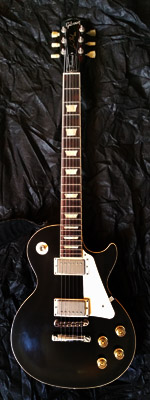
Les Paul Style
This style is based on the legendary Gibson Les Paul. It has a single cutaway and a bigger, thicker body than the Strat or Tele. It has two pickups and they are the larger, double sized type called Humbuckers (remember this, it’s important).
These days Les Pauls are most associated with Rock guitar thanks to Jimmy Page from Led Zeppelin and Slash from Guns ‘n’ Roses. However, they were designed to play Jazz as well as ‘pop’ music and still do that job just as well. Don’t pigeonhole them as solely ‘Rock Machines’.
Les Pauls tend to have a thicker, more full bodied sound than Strats or Teles, mostly due to the larger pickups. This means they don’t cut through a busy orchestration as well. Because of this they’re not used in pits as often as the other two. However, they are still a good choice if the show has a small band or if the music is mainly Rock or Jazz.
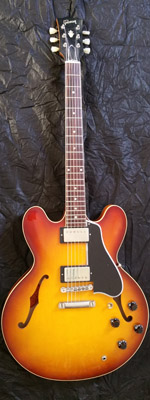
Hollowbody Style
This style isn’t named after a specific model. It’s descriptive. These guitars are at least partially hollow. They have f-holes or some other kind of opening in the body to let air move. The most famous model of Hollowbody is the Gibson ES-335.
This style has a larger body at least the size of a Les Paul, often bigger. They normally have the larger Humbucker pickups like a Les Paul.
Hollowbody guitars are usually thought of as Jazz instruments, although Jazz puritans might disagree. They have an even thicker, fuller sound than Les Pauls, with the associated problems of being lost in a dense arrangement. However, they would be an appropriate choice for a traditional musical where the music has a 30s-50s feel.
While they’re stereotyped as Jazz instruments, it’s worth noting that Holowbodies have been used to great effect by many Rock and Indie bands. Oasis, Foo Fighters and Kings of Leon all feature them heavily. No one would accuse them of being Jazz. Don’t be alarmed if your guitarist turns up for a Rock show with a Hollowbody.
Electric Guitar controls
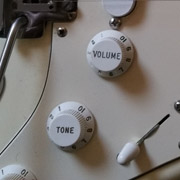
Now you know about the types of guitar, what do their various knobs and switches do? Fortunately there are only 3 types to understand: volume controls; tone controls; and pickup switches.
Volume controls turn the volume up and down, simple as that. Tone controls will remove some of the treble, the brightness, from the guitar’s sound. I tend not to use these much in Musical Theatre work. They can be difficult to adjust precisely, especially while playing. Some guitarists make much more use of them, but there are more relevant controls coming up that you’re more likely to ask your guitarist about, so don’t get too hung up on the guitar’s Volume and Tone controls.
Pickups
The pickup selector is important. It determines which of the pickups on the guitar is working at any given time. This has a significant effect on the sound. The pickup closest to the neck will sound warm, thick, maybe a little muffled. The one nearest the bridge will sound bright, sharp, maybe a little harsh.
If you’re finding you can’t hear the guitar or it lacks definition, you could ask the guitarist to try a brighter pickup. Conversely, if the guitar is sounding too harsh or piercing then requesting warmer pickup might help.
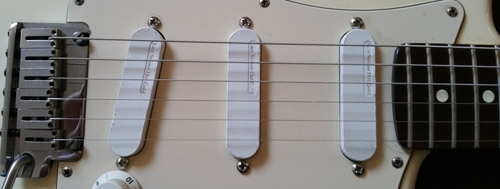
There are two common types of pickup. Strats and Teles usually have ‘single coil’ pickups, a single bar much thinner than it is long. These are brighter and more piercing than other varieties giving these guitars their signature sound.
Unfortunately, single coils can be prone to electrical interference in the form of a hum. This lead to the development of double coil pickups which eliminated the hum. These became known as Humbuckers. As we’ve mentioned, these bigger pickups have thicker, fuller sound.
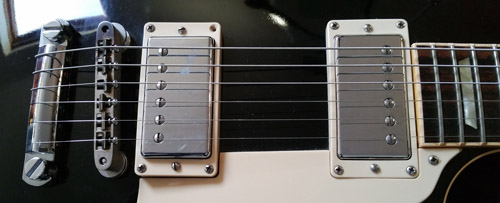
Sometimes Strats or Teles are modified to have a Humbucker instead of a single coil in one or more position, giving them different sonic options. This isn’t better or worse, it depends what is right for the show.
I might upset a few guitar geeks here, but to me the pickups are the biggest individual component in the sound of any electric guitar. That’s why I’ve discussed them in so much detail. Generally single coils are bright, present, clear and energetic. Humbuckers are thick, full, powerful and warm. There are always things the guitarist can do to modify this further down the line, but it’s good to understand the basic tone you’re starting with.
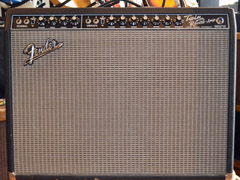
Amps
Having talked about guitars we need to look at Amplifiers. Guitar amps are often overlooked in Musical Theatre possibly because they’re incorrectly assumed to be like keyboard amps, taking a complete sound and making it louder.
The guitar amp is an integral part of the instrument’s tone. It really is half of the instrument. The sound produced by the guitar alone is thin and unpleasant. Think of the electric guitar as like a trumpet mouthpiece or an oboe reed. It can make a sound but without the rest of the instrument it’s not a very nice sound. The amp gives the guitar resonance, body and tone as well as volume.
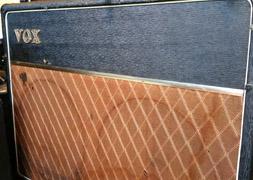
These days professional Musicals often want ‘silent pits’, where the musicians don’t have amplifiers projecting sound into the auditorium. Instead we monitor our sound using headphones. In this case the guitarist needs an amp emulation device which mimics the effect of the amp on the tone of the instrument.
As a very broad overview we tend to think about 3 basic ‘flavours’ of amp, Fender, Vox and Marshall. Fender amps tend to be thinner, clear and bright, much like single coil pickups. Vox is often described as ‘chimey’ with a slight mid-range push. The Beatles and Queen used them. Marshalls are thick, full bodied and mostly used for Rock. They are the humbuckers of the amp world.
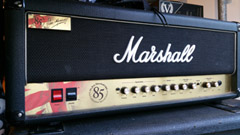
Unless you have a specific sound in mind, let your Guitarist bring whichever amp (or amp emulation device) they choose. I’ve mentioned them to explain the importance of the amplifier to the sound. However the guitar and effects provide easier and more versatile ways to adjust the overall tone.
Effects
This leads us to guitar effects. What are all seemingly infinite variety of little boxes and pedals guitarists have at their feet? These are effects we can switch on or off to alter the sound of the instrument. Sometimes they come in individual units called pedals or ‘stompboxes’ which tend to do one effect each. Alternatively you can get larger units that contain a number of different effects called ‘Multi-effects’ (MultiFX for short) or ‘Floorboards’. Both types do similar things and one is not better or worse than the other.
I’ll go through the common effects which crop up in a Musical Theatre context.
Overdrive / Distortion
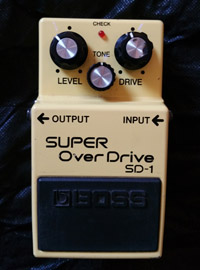
Overdrive or Distortion is the term we use for the distorted ‘Rock’ guitar sound. The normal, jangly sound of the guitar is described as clean. From there we can add increasing amounts of Overdrive.
I’d suggest thinking in terms of four levels of overdrive you might ask for. The first is Light Overdrive, something like the Rolling Stones or Bryan Adams. You can still hear some of the detail of the guitar but it has a “crunch” to it.
From there you could go to a Medium Overdrive. This is thicker and more powerful but retaining a little bit of clarity. Think of AC/DC, Queen or Led Zeppelin.
Next would be Heavy Overdrive, or Distortion. We’re talking full on Rock / Metal sound. Guns ‘n’ Roses, Foo Fighters, that kind of thing. Lots of power and aggression at the expense of clarity of individual notes within chords. This sound is also good for intense, prominent melody lines.
Finally you could ask for a full on epic Lead Solo sound. I’d take this to mean very distorted, louder than everything else, singing single note solo tone.
It’s important to know that levels of Overdrive are not linked to volume. It should be possible to ask for a quiet Heavy Overdrive or a really loud Light Overdrive. Overdrive refers to how distorted the sound is, not how loud it is.
Modulation Effects
Modulation effects is a catch-all term used to describe effects which alter the pitch or volume of the guitar. The most prevalent Chorus but it’s worth knowing about a few others too.
Chorus
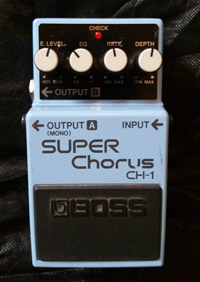
The Chorus effect creates a slight wavering and thickening of the guitar sound, making it seem to shimmer. This is popular for adding emotion to clean guitar parts. It’s often used on ballads and heartfelt love songs – as a result it comes up a lot in Musical Theatre. It can sound cheesy if overused, but does make a clean guitar sound more lush and less stark, direct and percussive.
The two main controls on Chorus are speed and depth which control how fast and broad the wavering of the sound is. The higher these controls are the more intense and obvious the effect will be.
It’s worth getting to know the sound of Chorus on electric guitar because it’s widely used and something you may want to ask for if you’re finding a clean guitar sound too to thin or harsh for a particular number. After Overdrive it’s the effect I am asked for most often by Musical Directors.
Phaser
A Phaser effect produces a subtle sweeping effect, but unlike chorus it can thin out the guitar sound. It’s useful for adding some movement to guitar parts. It often comes up in funky clean rhythm parts or sometimes to add interest interest to overdriven sections and solos.
As it’s usually a subtle effect I tend to add a Phaser where I think appropriate. It’s not often requested explicitly in scores or by Musical Directors but it’s worth knowing about.
Flanger
A Flanger is a very dramatic sweeping effect. It doesn’t come up often in Musical Theatre work but might be a useful ‘special effect’. When used with overdrive it produces a swooping ‘jet plane’ sound.
Tremolo

The Tremolo effect is a rapid fluctuation in the volume of the guitar sound. It can add drama and excitement to clean or overdriven guitar sounds. It was popular 50s and 60s Rock and Roll because early amps often had Tremolo effects built in. It seems to come up quite often in shows, despite not being so common on the gigging scene.
Like Chorus, Tremolo has speed and depth controls. In this case they control the rate of the volume oscillation and how deep it goes. A shallow depth will only produce a small change in volume while at full it will go from silent up to normal volume and then back again.
Wah Wah Pedal
One of the most distinctive sounds in electric guitar, the Wah Wah pedal is the classic, some might say clichéd, 70’s funk sound. It’s the sound of the Theme from Shaft. It’s a very obvious effect so only used when really necessary. If you’re wanting that ‘wakka wakka’ sound, ask for some Wah.
Echo effects
There are two common types of echo effect, Delay and Reverb.
Delay
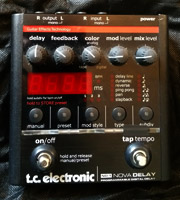
Delay (sometimes just called Echo) is where the note repeats at set intervals, usually slowly fading away. A short single repeat is often called a ‘slap back’ echo and gives a distinct 50s-60s Rock and Roll or Rockabilly effect.
Longer delays can be used to give body and breadth to guitar parts, and make overdriven sections and solos sound huge. If you want a guitar part to sound ‘bigger’ then delay can do that.
Another well known use of delay is to set it to the length of a dotted eighth note and play against it. This produces a characteristic U2 or Pink Floyd type sound. It comes up in the opening to ‘One Song Glory’ in the musical Rent.
Although Delay can sound great it can make the guitar sound dense and busy. This can sacrifice clarity and possibly dominate the overall sound of the band.
Reverb
Reverb replicates the reverberation of sound around a physical space. If you think of the way sound echoes around a church, cathedral or large music hall you don’t hear discrete echoes but there’s a trail of sound after the initial noise. Reverb imitates this.
It’s popular on electric guitar because there is no physical space in the body of the instrument to provide natural reverberation. The direct sound from the guitar can sound stark, present and ‘in your face’. Some tastefully applied Reverb can smooth this and blend the sound with everyone else, although too much can swamp everything and make you sound like you’re playing down a well.
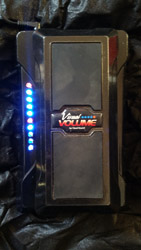
Volume pedal
I always have a volume pedal when I play shows. It allows me to adjust my volume without having to stop playing and use the volume control on the guitar. It’s particularly useful because Overdrive effects make it difficult to reduce volume solely by adjusting technique. A volume pedal is necessary for heavier overdrive sounds at lower volumes.
Summary
There you have it. A whistle-stop tour of guitars and effects. As well as understanding the technology hopefully you have picked up some of the terms used to describe guitar sounds – thin, warm, bright, thick, heavy, crunchy and so on. These are terms that other guitarists should understand and respond to.
As with any instrument you can mostly rely on the musician to make appropriate choices of guitar, sound and effects. What I’ve tried to do is give you enough background information that when you want to request something particular you have an understanding of how guitarists talk about their sounds.
If you have any questions or want to know more about any specific area let me know in the comments below or email me on matt@matthelm.co.uk
I am grateful to Chandler’s Guitar Experience for letting me photograph some of their amps and Kit Craig-Lowdon for allowing me to photograph his beautiful Gibson Custom Shop ES-335 Hollowbody.

